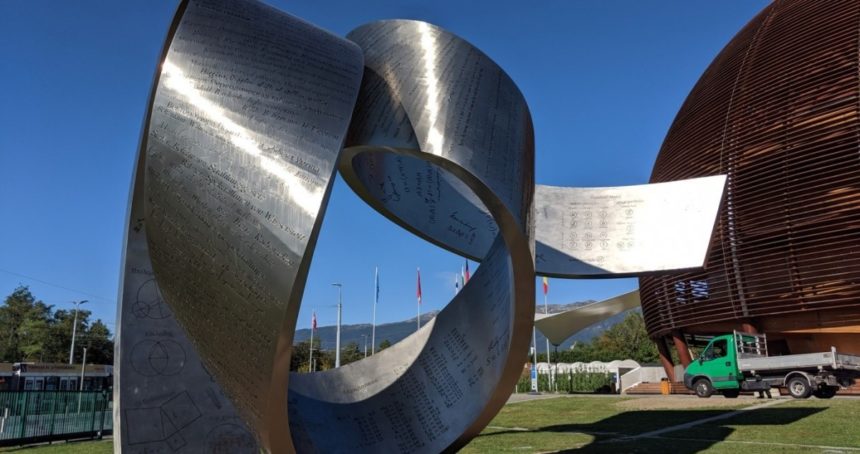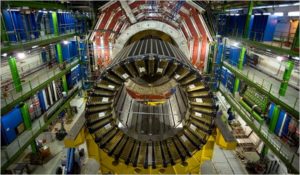Contributions of Indian mathematicians are recognised at the highest level of science but the Indian populace seems to be totally unaware of these significant achievers.
Ancient India Mathematicians and CERN

We had gone to Switzerland to soak in the beauty of pristine nature. It had been a dream of sorts. While staying in Geneva we realised that apart from the well known international organisations like WHO, WTO, ILO, ITU etc, the great international scientific laboratory CERN was also situated within this city. The famous scientific organisation CERN is well known for its cutting edge research in the esoteric field of particle physics. In fact, most of the enhancement in the knowledge about the basic structure of matter comes from CERN and its experiments. The latest technology of the large particle collider called the Large Hadron Collider and its search for the so-called ‘God particle’ had captured the popular imagination. Apart from its other achievements, it is pertinent to note that CERN is credited as the inventor of the internet as we know it.
CERN has a public face where anyone can visit their museum and basic display centre to get an idea about what it stands for. It actively encourages the general public to familiarise themselves with the cutting edge developments in theoretical physics. There is a well-maintained room explaining the cosmological concepts of the universe.
The core focus of particle physics these days is the particle accelerators which help in colliding particles at high energies, resulting in various decaying radiations which help in decoding the structure of matter at ever-increasing resolutions. There are old particle accelerators on display in the open area at CERN.

(An old particle accelerator)
In the CERN Campus, there is a unique globular structure where explanatory sessions are held for visitors. This structure is in a semi-globe shape with a version of Mobius strip made of metal that is attractively situated in front of the dome-shaped building.

(The Metal Mobius strip)
This Mobius strip contains a lot of basic scientific formulae and other details carved on its curved surface.
As the visitor nears the strange metal strip it becomes clear that there are multilingual writings all on it. Closer scrutiny reveals some known names and then it dawns that it contains the names of famous scientists and mathematicians from across the world. To the extent possible, the names of various scientists are written in the script of their native language. True to the spirit of a real multinational and multicultural organisation, this small touch seems very appropriate. It is such a pleasant surprise to see Indian names written therein Hindi (Devanagari script). It is another matter that the names written here are not something which is known within India to the general population or even the science or mathematics students.
It is a poor reflection on our educational system when we come across these names where their contributions are recognised in the top scientific institution of the world, so far away from home. The names mentioned here, Brahmagupta, Bhaskara II and Madhava were titans in their field and leaders of mathematical thought of their era. It is another matter that our cultural enslavement has ensured that there is no recognition within the larger society of their contributions. The role of scientific advancements in ancient India has always been a victim of prejudiced analysis, frequently based on deep-rooted antipathy due to the feeling of intense shame inculcated by the British tutored version of our heritage. The lazy brand of scholarship which perpetuated the incestuous doctrine based on quoting each other without ever going into actual details has done immeasurable damage to the due claims of recognition to these pioneers of mathematical thought.
माधव, शंकरा – अनंतश्रेणी
भस्कराचार्यद्वितीय :नाक्षत्रवर्षकीलम्बाईकानाप 365.2588 दिन
ब्रह्मगुप्त :शून्यएवंऋणसंख्या
While it has been well known that Indians are credited with the invention of Zero, it was Brahmagupta who codified the use of zero as an operator in arithmetic manipulations. He was born in 598 CE and died in 668 CE. The period between 400 and 1300 CE was extraordinary for the development of mathematics and astronomy in India. The famous mathematician and astronomer Aryabhatta, based in Patliputra during the Gupta era, gave the theories of the decimal number system, number series and trigonometry during late 5th century CE. He was one of the earliest to calculate planetary motions and determine that the earth goes around the Sun. Aryabhatta is well known within India and a large chunk of this social awareness is due to the naming of the first indigenous satellite after him, in 1975.
Brahmagupta and his contribution to mathematical growth are well documented and cannot be wished away by the detractors as something only known through tradition with no real written proof. For far too many of Indian advancements, this usual stratagem is used by the so-called experts and historians to denigrate any achievements of ancient India. There are two books available that were written by Brahmagupta, known as BrāhmasphuṭasiddhāntaandKhaṇḍakhādyaka which give the details of his mathematical treatise. He was the first person to give the rules for arithmetic operations to deal with zero and negative numbers. This was a major advancement over the then prevalent understanding of zero or ’nothing’ under the Ptolemaic or Roman systems at that time. It forms the bedrock of the decimal number system operations. Apart from this profound contribution, he gave the methods of solution of linear equations and simultaneous equations.
Bhaskara II is another name inscribed here in CERN. He was a great mathematician based in the observatory in Ujjain during the mid to late 12th century. The same institution which hosted Brahmagupta 500 years earlier and had another great Varahamihira during the period of 505 CE to 587 CE. It is evident that there was a great tradition of erudite scholarship in India and there has been a succession of great mathematicians who built up the fundamental underpinnings on which the modern developments are predicated. Bhaskara II expanded the ideas of number system propounded by Brahmagupta. His books Lilavati and Bijaganita are a master treatise on arithmetic and algebra. He was the first to institute a system of denoting the coefficient of algebraic terms by letters. The number system developed to its perfection became the base on which modern mathematics has been built. He gave many methods for solutions to the problem of quadratic and other equations. In fact, every school student uses Bhaskara’s solution for solving the quadratic equation without ever realising that the creator of this solution was this 12th-century Indian mathematician.
Bhaskara has been mentioned here with another intriguing detail. After his name, the following point is mentioned:
Length of the astronomical year – 365.2588 days.
It may look like an innocuous fact known to everyone throughout the world but to decipher the importance of this discovery, we have to see the time period of Bhaskara II’s life – 1114 to 1185 CE. During that time the Europeans were deep in medieval darkness and scientific advancement was far away in the future. That is why a civilisation that is at its technological peak at present, recognises the importance of this exact measurement of the year (accurate almost to the minute) by this Indian astronomer as a great achievement.
Another name mentioned in the strip at CERN is of Madhava. He was a mathematician in Kerala during the period 1350 CE to 1425 CE. He was the first person to expound the theory of Infinite Series. He took the work of Bhaskara II forward and laid the foundations of trigonometric functions as Infinite Series. The works of Bhaskara II and Madhava provided the theoretical basis for the development of calculus by the European greats Leibnitz and Newton a few hundred years later. Apart from being the founder of mathematical analysis and developing tools used in differential calculus, Madhava was the first to create the idea of integration.
When we saw other names on the strip mentioned along with these Indian names, we find that there are many great personalities such as Galileo, Da Vinci, Kepler, and Copernicus. It is a telling commentary on our teaching syllabus and our ignorance of our heritage that every well-read schoolchild will be well aware of these foreign greats and almost no one will have any idea about the Indian greats.
The great advancements of Indian mathematics were taken to the European shores by the Arabs in the early medieval years. It is a travesty that the Indian number system is called the Arabic numeral system by the majority of the world when the contemporary Arabs themselves acknowledged it as the Indian system. How will the art world react if the art gallery and museums which display the works of masters of art are credited with the creation of the masterpieces instead of the artists?
CERN has been in news recently as it is going for the construction of a new particle accelerator which will have a diameter of 100 kilometres. It will have 3 times more power than the current accelerator which is known as the large hadron collider. Anyone can apply for the tour of CERN and a scientist takes the visiting group inside the CERN campus and explains the details of what exactly they do. As part of the tour, they show an old particle accelerator that has been decommissioned and is safe from any residual radiation.

(A Decommissioned particle accelerator)
It is while they are explaining the scientific experiments and their role in the understanding of the intricacies of matter that one comes across the so-called search for the GOD particle. It is a particle that was theoretically predicted by Professor Higgs and hence it is called the Higgs boson. The experiments done by CERN in the large hadron collider has been analysed by scientists across the world and it has been accepted that the existence of Higgs Boson has been proven by these experiments.
To the uninitiated into the highly advanced concepts of modern physics, Boson is a category of elementary particles which are found at the microscopic level. It is indicative of our ignorance of the talent of Indian achievers that the fact that the boson category of particles is based on the name of great Indian Satyendra Nath Bose is not common knowledge for the Indians. At best it is a quiz question among the science and technology graduates. It looks like we have been conditioned to consider ourselves as inferior people. All our achievements have been systematically denigrated and it has resulted in this deplorable scenario where we do not recognise our great scientists or mathematicians. Dr S N Bose was one of the leading scientists of the 20th century and such a great figure in science that the fifth state of matter (after the main 4 states of solid, liquid, gas and plasma) has been designated as Bose-Einstein condensate. This status refers to the status of matter found in the interior of stars where the atoms break down and the matter is made up of a jumble of elementary particles. A scientist whose name is hyphenated to Einstein and who lends his name to something as fundamental as a state of matter remains totally unappreciated in our own country. No wonder the creative energy of our country has been suppressed for so long. The experts who design and decide what our children should learn must take the blame for such oversight.
It is a well-recognised fact that only the Indic traditions among the world’s religion had the intellectual capacity to even think of the cosmological scale of the universe and related timelines. Indians have not only handled the concept of zero, but the ancient thought process had also successfully grasped the concept of the vastness of space, the enormity of the time scale and the basics of astronomy. It is no wonder that while the so-called elites never let go of any opportunity of denigrating Indic traditions, the foreigners who are not burdened by this fake ideology do not shy away from recognising this profound truth. Whether it is the approximate quotation from Gita, supposed to be said by the chief scientist Robert Oppenheimer when he saw the first test of the atomic bomb, or the naming of the first nuclear fusion test reactor as SHIVA by the Lawrence Livermore Laboratory in the USA, the top scientists have never been shy of acknowledging the profound impact of Indic thought.
Conclusion
The visit to this amazing scientific research centre made such an impact that we came back full of knowledge about our ancient gurus and thinkers and how oblivious we were to our own heritage. There is hope that our education system will duly acknowledge the contributions and students will learn about them just like they are learning about the contributions of western mathematicians and scientists.

Leave a Reply